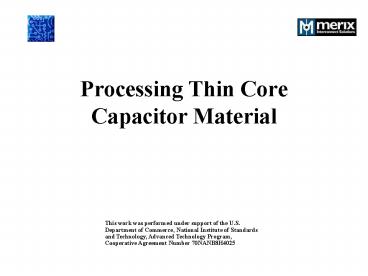Processing Thin Core Capacitor Material - PowerPoint PPT Presentation
1 / 15
Title:
Processing Thin Core Capacitor Material
Description:
UL qualification boards. Thin Core Projects. AEPT TV1-C Test Board ... Beginning board level qualification. Developing IPC standards for embedded passives: ... – PowerPoint PPT presentation
Number of Views:28
Avg rating:3.0/5.0
Title: Processing Thin Core Capacitor Material
1
Processing Thin Core Capacitor Material
This work was performed under support of the U.S.
Department of Commerce, National Institute of
Standards and Technology, Advanced Technology
Program, Cooperative Agreement Number 70NANB8H4025
2
Current Production with 2 mil P/G Cores
- Considerable production, increasing demand.
- Twelve to thirty layer boards, 0.093 thick.
- Typically with 1 mm pitch ASIC packages.
- 500 - 1500 leads.
3
Thin Core Projects 1 mil P/G Cores
- 3M C-Ply used to build boards for
- NIST Advanced Embedded Passives Technology
(AEPT) consortium TV1-C and TV2-C boards. - Nortel Emulator board (also includes a buried
resistor layer) for the AEPT project. - Sun Microsystems test boards.
- Prototypes for OEMs
- UL qualification boards
4
Thin Core ProjectsAEPT TV1-C Test Board
- 4 Layers
- 1 C-Ply core
- TV1-C Testing
- Temperature/humidity
- Thermal cycle
- Thermal shock
- ESD
- Other testing
- Pictorial view of the TV-1 capacitor design.
- 80 X 0.170 sq. capacitors
- 6 X 0.60 sq. capacitors
- 5 X NIST capacitor patterns
- 3 X daisy chain array capacitors
5
Thin Core ProjectsAEPT TV2-C Test Board
- High frequency (gt5 GHz) test board
- 8 Layers
- 2 C-Ply cores
- Microvias
6
Thin Core Projects Nortel Emulator Board
- 14 Layers
- 4 C-Ply cores
- 1 Embedded resistor layer
- Microvias
- Emulates existing high-speed board with buried
components.
7
Current Thin Core Projects Sun Microsystems Test
Boards
- 20 Layers
- 4 C-Ply cores
- Microvias
- Provided impedance and EMI data
- Also built with 1 mil FR4.
C-Ply cores separated by regular core.
8
Current Thin Core Projects Prototypes for other
OEMs
Adjacent C-Ply cores.
Single C-Ply core in center.
9
Thin Core Experience Equipment
- Pre-Clean in place, required modification.
- Laminator in place, required modification.
- Print in place.
- DES in place.
- Hi-Pot in place, required modification.
- PEP in place, required modification.
- AOI in place.
- Lamination in place.
- Electrical Test in place
10
Thin Core Experience Volumes Yields
- We have processed 1600 ft2 of C-Ply to date.
- Yields of a pilot board are running 75.
- Yield issues include
- Handling damage.
- Hi-Pot failure.
- Registration related to scaling.
- Power to ground Shorts.
- Yields are steadily improving.
11
Thin Core Experience Lessons Learned
- Two approaches to etching thin core
- Standard etching (etch both sides at the same
time). - Sequential etching (etch only one side, laminate
into subpart, then etch second side.
12
Thin Core Experience Standard Etching
- Border Modifications
- No overlapping etched features.
- Full copper out to panel edge.
- No overlapping innerlayer vents.
- Potential Problems
- Laminate tearing along edge.
- Particle generation.
- Loss of tooling hole integrity.
13
Thin Core Experience Sequential Etching
- Process Modifications
- Image and etch first side of material.
- Laminate into a subpart.
- Image and etch second side of material.
- Potential Problems
- Registration of second side image to first side.
- Subpart registration to parent part.
- Subparts are more prone to epoxy spots that can
create shorts.
14
Thin Core Experience Challenges to Implementation
- Equipment with thin core capability is vital.
- Training in thin core handling is key.
- Defect density of the material.
- Material movement during lamination.
15
UL Qualification and IPC Standards
- Pursuing UL qualification
- Working with 3M on laminate qualification.
- Beginning board level qualification.
- Developing IPC standards for embedded passives
- Material specification.
- Board performance specification.
- Design specification.































